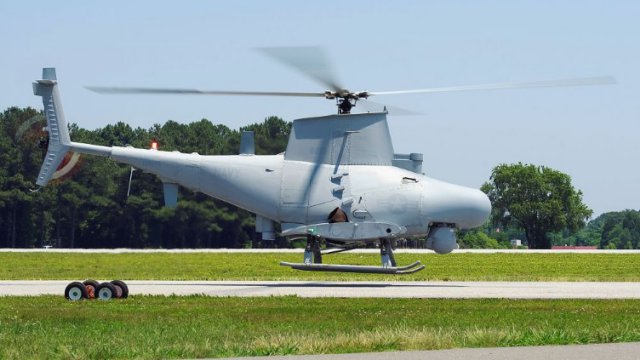Northrop Grumman debuted its MQ-8 Fire Scout shipborne rotary-wing unmanned air system to potential European customers at this year’s Royal International Air Tattoo.
Northrop Grumman is hoping that the debut of a full-scale mockup at the show, held on July 13-15, will help to build awareness of the capability of the platform as navies in Europe consider the wider introduction of unmanned rotary-wing air systems on the back of their warships.
Two iterations of the Fire Scout are currently in service with the U.S. Navy: the MQ-8B, based on the airframe of the Schweizer 333 piston-powered light helicopter and the MQ-8C based on Bell’s 407 single-engine light helicopter. The navy is hoping to achieve an initial operational capacity with the MQ-8C by the end of 2020.
U.S. Naval Air Systems Command announced on July 9 that the MQ-8C had completed the first comprehensive initial operational test and evaluation of the system from the littoral combat ship (LCS) USS Coronado.
While the MQ-8B has seen operational service, the larger MQ-8C was born out of an operational need by the DoD to get additional range, altitude and persistence, says Jack Thomas, Fire Scout director of mission engineering. The company looked at a wide range of airframes before settling on the Model 407, taking into account such features as internal volume and low airframe weight.
“Bell did a great job of taking weight out of the aircraft…and the only modification we needed was the dual-channel FADEC [full-authority digital engine control],” says Thomas.
“That is now standard in the commercial aircraft,” he adds.
With 19 in service and Northrop Grumman contracted to produce 14 more, the navy currently plans to use the MQ-8C from its growing fleet of LCS as part of a composite aviation detachment combined with a manned Sikorsky MH-60S Seahawk, but also had plans to use it from other platforms including the T-ESB-4 expeditionary mobile base vessels, the first of which was acquired by the navy earlier this year.
The navy has already proven the Fire Scout’s ability to buddy-lase targets for the MH-60’s Hellfire missiles. Northrop Grumman is now in the process of integrating the Leonardo Osprey lightweight active electronically scanned array radar for surface search. The navy is also mulling additional sensors as well as the ability to arm the aircraft.
The navy is also looking to increase endurance further with upgrades to reduce the specific fuel consumption of the Rolls-Royce 250 turbine. Other potential upgrades envisioned by the navy include control of the Fire Scout from the MH-60.
At the Air Tattoo, the mockup was displayed with Ultra Electronics’ Sonobuoy Mission Pod, a dispenser able to carry 25-63 sonobuoys, potentially paving the way for such unmanned air systems to support the anti-submarine warfare mission.
The Fire Scout’s landing capability is provided through the Unmanned Common Autonomous Recovery System, which uses a millimetric wave radar to acquire the aircraft and feed it with data on the ship’s position as well as its heave in the waves. As it returns, a safety observer has the option of sending the aircraft around for another landing attempt if he feels the conditions are not conducive to a safe landing. The Fire Scout is an entire autonomous system, with operators guiding the aircraft by mouse click.
“It is a fully autonomous helicopter from a procedure standpoint,” says Thomas, and the mission can be reprofiled in-flight.
“The navy is out ahead in terms of unmanned teaming.…They are building the tactics, techniques and procedures that leverage the attributes of each of the systems,” says Thomas. So far, other nations have proved slow to embrace unmanned helicopters from their warships, but interest is growing. Several nations have shown interest in the MQ-8B-model platform in particular, and with the resumption in production of Schweizer aircraft by Texas-based Schweizer RSG after buying the intellectual property, tooling and inventory of the Schweizer family, exporting MQ-8Bs could be an option. The navy is “deliberating” about the future of having the two models in service, says Thomas.
“Once we see LCS deployed in quantity and partner nations see us doing that, there will be more interest and less reluctance in shipborne unmanned helicopters,” suggests Thomas.
Source: Aviation Week

